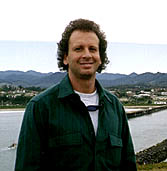
April 24, 2000
UCSC teams up with The Nature Conservancy to study and protect coastal waters
By Tim Stephens
A new partnership between UCSC and The Nature Conservancy aims to put the best available
scientific information to work in the area of marine conservation and management.
A cooperative agreement signed last month provides the foundation for an effective
working relationship between the Institute of Marine Sciences (IMS) and the Conservancy's
Coastal Waters Program, said IMS director Gary Griggs.
 |
| Michael Beck |
The Nature Conservancy, a private international conservation organization, focuses on preserving habitats and species by protecting the lands and waters they need to survive. The organization currently manages 1,340 preserves around the globe, the largest system of private nature sanctuaries in the world, including more than a million acres in the United States alone.
Griggs said he was impressed by The Nature Conservancy's emphasis on scientific research as a foundation for its strategies. The Conservancy uses information on the distribution and abundance of species, as well as other kinds of ecological data, to guide the management of its preserves, to identify and monitor threats, and to decide which sites need protection.
"Good scientific information from ecologists and biologists is integral to our work, and I think this is a great opportunity to get topflight researchers together with a large conservation organization with a strong scientific basis," said Michael Beck, director of marine science for the Conservancy's Coastal Waters Program.
Beck has set up an office on campus, where he plans to establish a modest research program, and has been meeting with IMS researchers. He expects to have opportunities for interns and research assistants, and may also serve on graduate student committees and do a limited amount of teaching.
Until fairly recently, most of the Conservancy's efforts in the United States have been aimed at terrestrial species and habitats, although it has had marine conservation programs in the Caribbean and Asia-Pacific regions and in the Florida Keys for many years, Beck said. The Coastal Waters Program was created to help the Conservancy and its partners develop a better understanding of marine organisms and ecosystems and more effective strategies for their conservation.
"There was a growing realization that we were missing a lot of biodiversity by focusing on terrestrial species," said Beck, who serves as a link between researchers and field staff.
"My responsibilities are to connect with people who can provide us with information on the distribution and abundance of marine species and the ecological processes that impact them, and to help develop scientifically informed strategies for their conservation. There are great studies being done by UCSC scientists, and I want to get that information to our field staff on the ground (and increasingly in the water) at our field sites," Beck said.
In recent years, the Conservancy has begun to shift its focus away from individual species and their habitats toward the protection of entire landscapes and ecosystems. This strategy is forcing the organization to deal increasingly with issues on the cutting edge of ecological research, Beck said.
He noted that UCSC researchers are involved in several projects relating to marine reserves and how ecological theory should be used to design and manage them. Marine biologists Peter Raimondi and Mark Carr, for example, are leading UCSC's participation in the Partnership for Interdisciplinary Studies of Coastal Oceans (PISCO), a five-year, $17.7 million project looking at the coastal environment and ecosystems from Oregon to southern California. Part of PISCO's mission is to communicate its findings to the public so that the findings can be used to develop sound policies.
"That kind of communication happens all too infrequently. Through this relationship with UCSC, we hope to provide more pathways for information to move out of the university, and we hope to find more opportunities for funding to support collaborations between the people doing research and the people applying it," Beck said.
With staff working at hundreds of field sites around the world, there are likely to be opportunities for the Conservancy to provide support for UCSC scientists conducting field research, Beck said. In addition, the Conservancy has just established a research program that will support 25 postdoctoral fellows over the next five years to work at Conservancy sites.
"The impetus for this program was that all too often our field staff are unaware of relevant ecological research, and many researchers are unaware of how their studies can address the most pressing problems in conservation. We want to bring these groups into closer contact," Beck said.
The Nature Conservancy has established partnerships with other academic institutions as well, including UC Davis, the University of Florida, and Cornell University. At UC Davis, the partnership focuses on the problem of invasive exotic plant species.